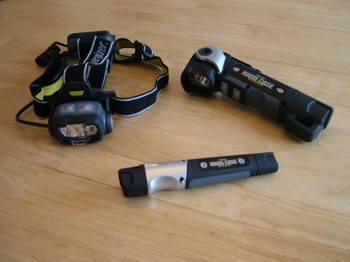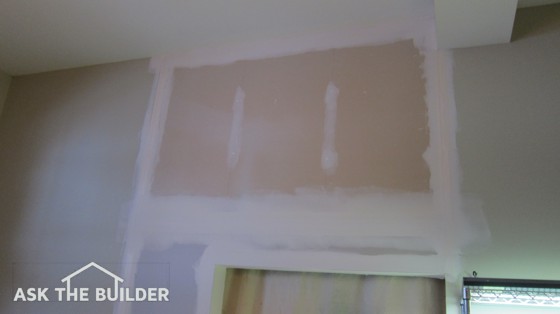DEAR TIM: An LED flashlight is on my must-have list of tools to buy. Do LED flashlights really live up to all the marketing hype? I want a bright LED flashlight, so do they come in different intensities? Can you get a super-bright LED flashlight? What other features should I look for as I shop for these fascinating flashlights? Stan S., Kirkland, AZ
DEAR STAN: I have more than one white LED flashlight, and they’ve become my favorite ones. I don’t think I’d invest money in a company that makes those tiny incandescent bulbs you find in traditional flashlights as LED flashlights will surely become the standard, if they aren’t already.
You mentioned that you want a bright LED flashlight. I don’t think they come any other way. In fact, many people complain LEDs are too bright. I find that the beam, when directed into my eyes, can be painful. You absolutely can buy LED flashlights that produce different intensities of light. The usual measurement of brightness is lumens.

These LED flashlights produce powerful beams of white, red and green light. PHOTO CREDIT: Tim Carter
I have a fabulous LED headlight that has a powerful beam that measures 100 lumens. It has a switch that allows me to produce less light if the main beam is too intense. Other flashlights I own produce 80 lumens and one smaller inspection LED flashlight produces just 25 lumens. This small LED flashlight is not much bigger than a cigar, but 25 lumens is a lot of light! I also like this small light because the case isn’t round. If I set the flashlight on a sloped surface, it doesn’t roll away.
There are many features you should look for. Some depend on what you intend to do with the tool. For example, I own one LED flashlight that requires no batteries. It’s a crank LED flashlight. Inside the tool is a miniature generator and a battery. You wind it up, and it makes light. This is great for a car or camping when you feel you need to store a flashlight, but don’t want to be hassled wondering if the batteries will be charged when you need the tool.
Look for LED flashlights that are impact tested. This means that if you drop it from some height, it will still operate. Some that I own will survive a 15-foot drop. That’s pretty impressive as far as I’m concerned. I want durability, not a fragile flashlight that stops working if I drop it just three feet from my hand to the ground.
I would look for a red LED flashlight. That doesn’t mean the outer case is red, it means that the tool has red LEDs. These special flashlights have one or more LEDs that produce red light. Red light is easier on your eyes at night because when it’s dark, the pupils of your eye dilate to accept more light. The red light is not as intense and allows you to illuminate objects while your pupils stay dilated.
If you use harsh white light at night when viewing something up close, your eyes react negatively. I’m sure you’ve had this happen to you when driving at night. If an idiot approaches you with their high-beam headlights on, you lose your night vision as you pupils contract because of the massive amounts of light entering your eyes. Two of my LED flashlights have both the white LEDs and these red ones. In fact, they have a third unique LED that’s green!
The green LED in two of my flashlights is very remarkable. Green light, as opposed to white light, is the most friendly light for our eyes. Scientists have told me that the human eye response is peaked at a wave length of about 555 nanometers. Green light is visible anywhere from 490 to 560 nanometers. This green light improves depth perception and contrast. If you use green light to inspect things for cracks, slight imperfections, etc., you’ll see them faster and easier than if you use bright white light. I never knew that!
Absolutely get LED flashlights that are waterproof or water resistant. You never know when you’ll be out in the rain or working in a damp area. All of my flashlights are water resistant.
Consider getting a headlight LED flashlight. This is one that you wear on your forehead like a miner. The one I have has comfortable elastic straps that adjust easily. The light itself swivels up and down so it’s easy to adjust where the beam of light is focused. Using this light allows me to work with both hands and the light is always where I’m looking. I love my headlight flashlight and kick myself for not getting it years ago. Mine is equipped with white, red and green LEDs!
A rechargeable LED flashlight is not a bad idea, but make sure you plan to use it where you always have access to power. Once these tools run out of stored power, they are useless until recharged. That’s my only complaint - the fact that while recharging, you have no light at all.
The LED flashlights typically use less battery power as the LEDs simply can produce more light with less energy than a traditional incandescent bulb. But the more LEDs you have in your tool, and the more lumens they produce, they can burn through batteries. Always pack extra batteries. I love using the newer rechargeable AA and AAA batteries in my LED flashlights. I always have plenty of fully charged batteries on hand.
Below are Amazon.com affiliate links for these LED Flashlights.
Column 773

